APPS
Facebook targets emerging markets with the launch of Instagram Lite, an Android app that takes up just 2MB, in 170 countries

Growth for Facebook is coming from the developing world, and so the social network today made another key move to cater better to consumers in those countries. After nearly three years in the planning, Facebook is taking the plunge today and officially launching Instagram Lite, a less data- and storage-intensive Android-only version of its popular photo and video app. It will take up just 2MB on a phone, and it is going live in 170 countries, with a focus on emerging markets, today.
Instagram Lite is launching with all the basic bells and whistles around editing, sharing and viewing photos and videos, as well as the ability to add stickers, create and view Stories, IGTV and the Explore discovery and recommendation algorithms. And given the launch across 170 countries, it’s coming with specific language support to be usable in those markets.
But to whittle down the experience from the 30MB that full-fat Instagram takes up on iOS and Android devices (and countless MB of mobile data usage), it’s launching without some things, too.
Namely, the developers have left out many graphics; they haven’t included advertising; and it’s missing some key features like the ability to make TikTok-ish Reels (you can still view them), dark mode, Shopping and end-to-end encryption. (Notably, encryption was reportedly being worked on for the main app in 2019, but it has yet to launch). Nor are there iOS or feature phone versions of the app in the works.
Facebook said that some of that list — such as dark mode and (of course) adverts — will be added in future updates.
Instagram Lite has been teased out in different forms by Facebook since 2018, and it’s hitting what has proven to be a receptive market for the social media giant. Tzach Hadar, Tel Aviv-based director of product management for all of Facebook’s Lite apps — which also include versions of Facebook and Messenger, also built in Tel Aviv — said this week that Facebook Lite now has more than 200 million monthly active users.
That’s just a fraction of the billions that use Facebook itself, but represents a key way of targeting those newer to Facebook or those who might not otherwise be using the app because of financial or bandwidth constraints.
But although Instagram is wildly popular and would have been an obvious candidate for the Lite treatment years ago, and Instagram Lite was one of the most requested items from users in developing markets, it has proven to be a trickier beast.
That’s not just because the app focuses on images and videos, which by their nature use up more bandwidth and data; but because over the years Instagram has become increasingly laden with features: those aimed at enhancing the user experience; those aimed at competing better with other apps (hello, Stories and Reels); and those to extend monetization opportunities for Facebook.
“Instagram offered another kind of unique challenge for us to deliver under the same constraints the same experience,” said Nick Brown, a product manager based out of New York (the app was co-developed across Facebook’s Tel Aviv and NYC offices and — presumably, given the year we’ve had — across many Facebook employees’ homes). “The philosophy is really that we want to bring all of Instagram to these users.”
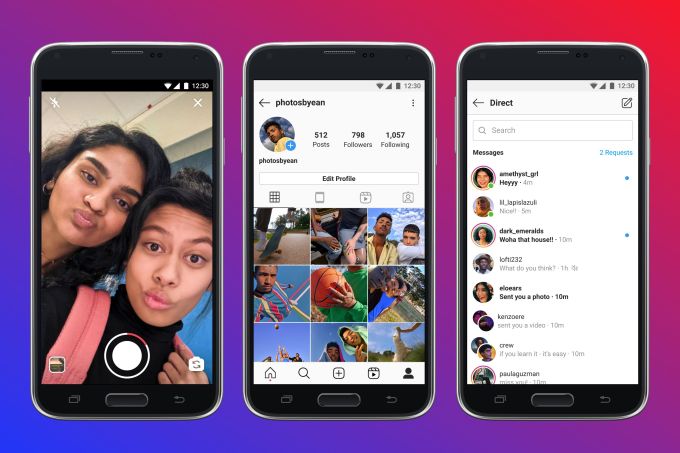
Image Credits: Facebook
Indeed, as with other Lite versions of apps like Facebook and Messenger, Instagram Lite is geared toward consumers in emerging economies, where smartphones are most likely to be Android-based and less likely to be top-of-the-range devices; consumers are more likely to be more price- and bandwidth-sensitive when it comes to using mobile data; and a substantial proportion are still only now getting to grips with being online.
Facebook notes estimates that show 65% of emerging market populations are online versus 90% in North America, which is one reason the company focuses so squarely on serving those users: they represent growth at a time when growth has slowed down, or become significantly more competitive against newer entrants, in its more mature markets like the U.S. and Europe.
However, building for the demands of developing markets can often, by their nature, run counter to the concept of building in ever more features as you might otherwise see with highly competitive consumer apps.
The Instagram Lite app had some fits and starts over the years, with the first version, built on the Instagram web stack as a Progressive Web App, launching in a limited release back in 2018, taking up a mere 573KB of space on a device. It also came without a lot of features, but Instagram itself had less features, too. While it was never explained why, that version was quietly pulled last year, and then shortly after a newer version was launched again in December in a limited test. Debuted first in India, a key market for the company, Instagram Lite launched there with support for Bangla, Gujarati, Hindi, Kannada, Malayalam, Marathi, Punjabi, Tamil and Telugu.
And it’s that last test that has turned into the official Instagram Lite app. Interestingly, it turns out that in the process, the whole app was rebuilt, moving it away from being a Progressive Web App and building it instead on another internal framework called Bloks (not to be confused with Bloks), heavy lifting a lot of the basic workings from Messenger and Facebook’s Lite versions.
I’ve asked for more detail about this. I’ve confirmed that it is not, however, related to LightSpeed, which was the name of a development project that saw a lighter and new version of Messenger get released last year. Bloks is a framework that enables both management logic to be defined once server-side and rendered as a native application that supports iOS, Android and web development and is integrated into Instagram, Facebook, Messenger and WhatsApp. Bloks has been used, for example, to build other Instagram features such as Shops.
“Bloks is a framework that is much more performant and has more features and capabilities, and this new Instagram light application is built upon it,” said Hadar. “So it’s like a new app altogether.” It’s not clear what exactly happened behind the scenes leading to the previous app getting pulled, but it seems that in any case the foundations now give the company more room for expanding the service (even while bumping up the app size from under 600KB to 2MB).
That fact might matter less to users, but does point to some notable trends at the company itself and how it’s approaching tech in the future, and also how it views the important of feature parity between full and Lite versions of its flagship apps.
Updated to correct that the earlier version of Instagram Lite was built as a progressive web app, not React Native, and to provide some further detail on Bloks.
APPS
Best ASO Tips To Boost Your App Search In 2022

You need your application to be really effective in the overpopulated application market. Then, at that point, you will have to drive downloads to endure. So when it’s all said and done, you must account for yourself. Get your application the consideration it merits.
The uplifting news, however, is that customers love to download applications – last year, we downloaded in excess of 200 billion applications around the world, and that figure is set to increment to 258 billion every year by 2022 as cell phone reception increments.
Assuming you need to be seen and have your application downloaded by however many clients as could reasonably be expected, then, at that point, you should begin by taking a gander at the application store.
Underneath, we’ve assembled probably the best application store improvement methods to assist you with creating more downloads in 2021 and then some…
Start with Your Application Name
The odds are you as of now have an extraordinary name for your application, yet an appropriately advanced application is about significantly more than marking.
Assuming you need to amplify transparency and guarantee you’re showing up when clients look for applications like yours, you ought to remember the primary keywords for your application name or title, comparable to how you’d make a title label while improving a site page.
You could begin with your application name so it tends to be plainly recognized, thus it appears on the home screen of gadgets.
Then, at that point, you can add a scramble or vertical bar prior to adding a few pertinent watchwords to your speciality, or even put your application name in quotes as we did with FORE Business Golf Networking.
Urge Users to Leave Reviews
You could ask for reviews by clients through the means of your site, or through an in-application notice toward the finish of their meeting, yet make sure to restrict the number of pop-ups you execute with the goal that you don’t disturb or disappoint your clients, as this could urge them to erase your application.
We’d support all application engineers and entrepreneurs to react to criticism on their applications, as this can further develop client relations and resolve issues in an open arena.
Zero in on Your Application Depiction
Your application depiction is your principle assemblage of text your landing page content, in a manner of speaking. Utilize a site like KeywordTool.io to discover information on your picked catchphrases to expand your openness. As portrayals are shortened, ensure you remember the main data for the initial three lines of your depiction, and afterwards add things like social confirmation, emoticon, and suggestions to take action to build commitment and downloads.
Incorporate Appealings Screen Captures
Pictures and recordings won’t help your application rank, yet they will expand changes and assist clients with working out whether it’s an application they truly need.
There’s a little guide in empowering clients toward downloading your application if in any case, they’re not going to interface with it, or download and leave a negative survey when they understand it wasn’t what was promoted.
Assuming you need to ‘tart up’ your item page, then, at that point, you can add marking and extra text and data and designs to your recordings and screen capture, yet they ought not to diminish your item.
Pay for App Store or Play Store
As we have SEO and pay-per-click, you need to work one next to the other (one is a gradual methodology with long haul benefits – the other is a speedy success yet requires an endless spending plan), application store promotions can be utilized to get the message out with regards to your new programming and assist you with positioning at the highest point of query items pages – in front of your opposition and enormous names in the application world.
Keep in mind, you’ll need to focus on the right crowd and art an advertisement that will assist you with changing over and that since you’re paying for situations, that doesn’t mean clients will download or cooperate with your application.
Wrapping Up!
You can employ a group of App Store Optimization Services suppliers to benefit a scope of application store improvement administrations, including watchword advancement, resource enhancement, and restriction to guarantee your application is seen by individuals that matter.
We have long periods of involvement in creating and showcasing applications and have assisted different customers with expanding their downloads by infiltrating rewarding and regularly undiscovered business sectors.
Author:
Prachi Gupta likes to write information about Digital Marketing Trends that can help audience to grow their business.
APPS
WhatsApp will finally let users encrypt their chat backups in the cloud
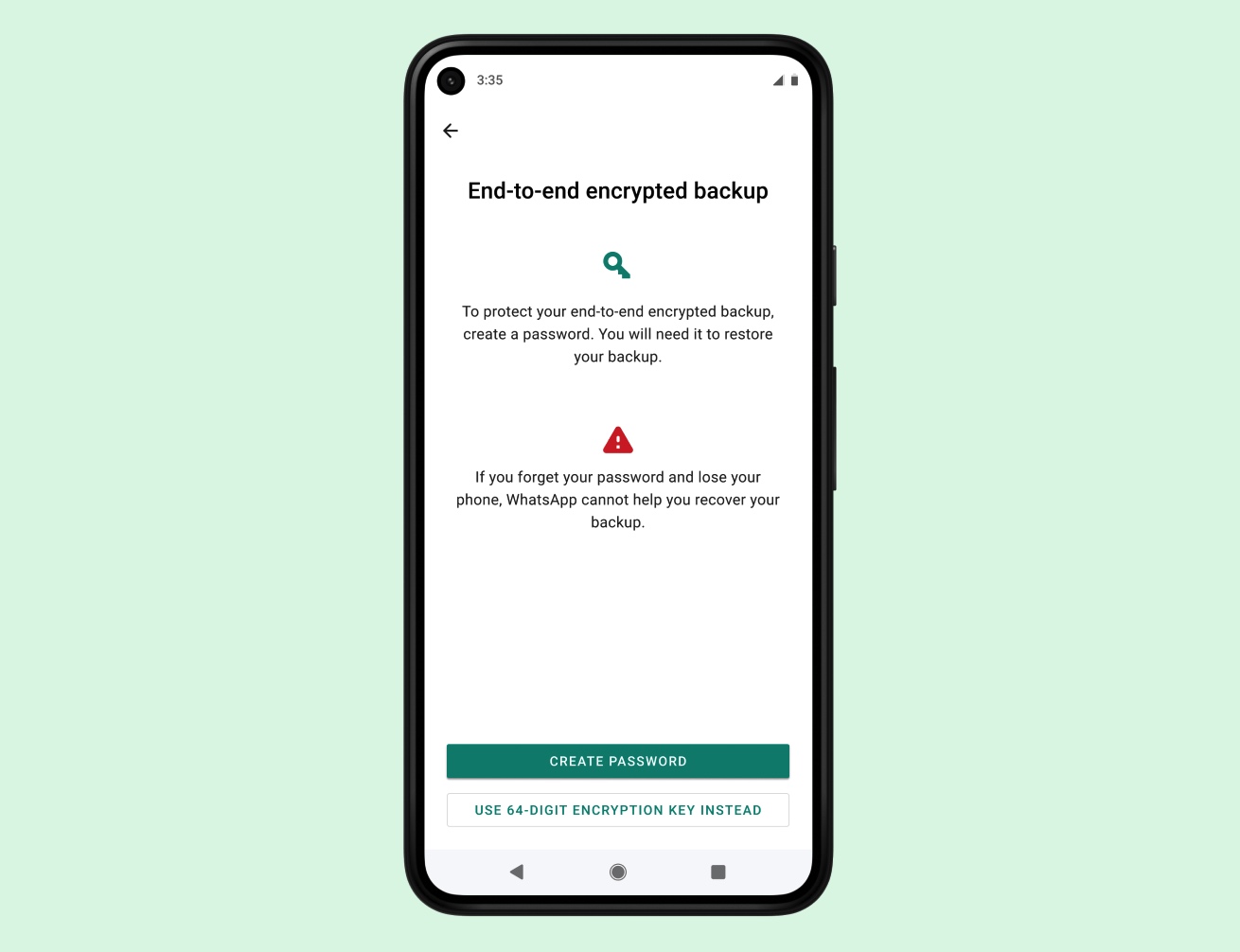
WhatsApp said on Friday it will give its two billion users the option to encrypt their chat backups to the cloud, taking a significant step to put a lid on one of the tricky ways private communication between individuals on the app can be compromised.
The Facebook-owned service has end-to-end encrypted chats between users for more than a decade. But users have had no option but to store their chat backup to their cloud — iCloud on iPhones and Google Drive on Android — in an unencrypted format.
Tapping these unencrypted WhatsApp chat backups on Google and Apple servers is one of the widely known ways law enforcement agencies across the globe have for years been able to access WhatsApp chats of suspect individuals.
Now WhatsApp says it is patching this weak link in the system.
“WhatsApp is the first global messaging service at this scale to offer end-to-end encrypted messaging and backups, and getting there was a really hard technical challenge that required an entirely new framework for key storage and cloud storage across operating systems,” said Facebook’s chief executive Mark Zuckerberg in a post announcing the new feature.
Store your own encryption keys
The company said it has devised a system to enable WhatsApp users on Android and iOS to lock their chat backups with encryption keys. WhatsApp says it will offer users two ways to encrypt their cloud backups, and the feature is optional.
In the “coming weeks,” users on WhatsApp will see an option to generate a 64-digit encryption key to lock their chat backups in the cloud. Users can store the encryption key offline or in a password manager of their choice, or they can create a password that backs up their encryption key in a cloud-based “backup key vault” that WhatsApp has developed. The cloud-stored encryption key can’t be used without the user’s password, which isn’t known by WhatsApp.
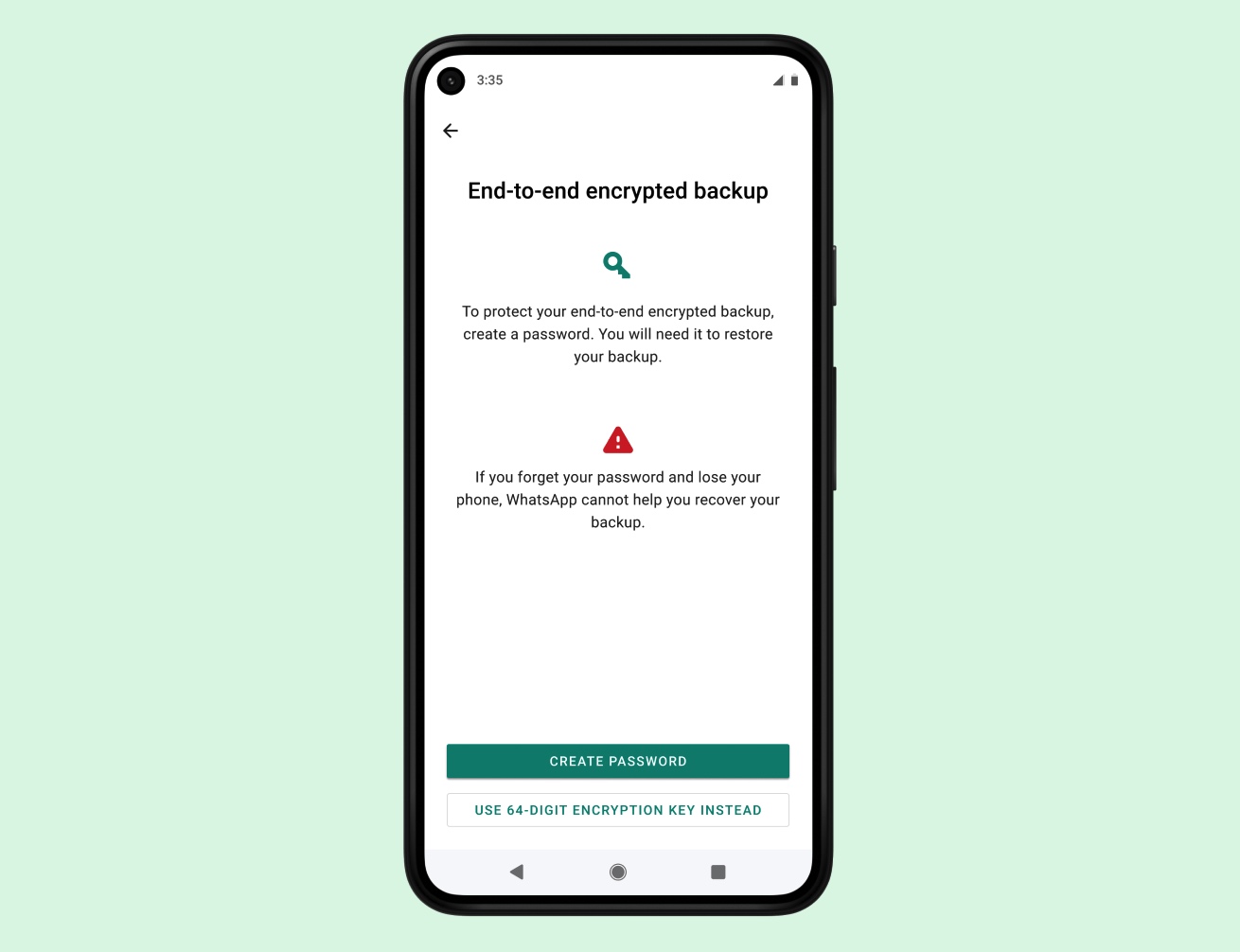
Image Credits: WhatsApp/supplied
“We know that some will prefer the 64-digit encryption key whereas others want something they can easily remember, so we will be including both options. Once a user sets their backup password, it is not known to us. They can reset it on their original device if they forget it,” WhatsApp said.
“For the 64-digit key, we will notify users multiple times when they sign up for end-to-end encrypted backups that if they lose their 64-digit key, we will not be able to restore their backup and that they should write it down. Before the setup is complete, we’ll ask users to affirm that they’ve saved their password or 64-digit encryption key.”
A WhatsApp spokesperson told TechCrunch that once an encrypted backup is created, previous copies of the backup will be deleted. “This will happen automatically and there is no action that a user will need to take,” the spokesperson added.
Potential regulatory pushback?
The move to introduce this added layer of privacy is significant and one that could have far-reaching implications.
End-to-end encryption remains a thorny topic of discussion as governments continue to lobby for backdoors. Apple was reportedly pressured to not add encryption to iCloud Backups after the FBI complained, and while Google has offered users the ability to encrypt their data stored in Google Drive, the company allegedly didn’t tell governments before it rolled out the feature.
When asked by TechCrunch whether WhatsApp, or its parent firm Facebook, had consulted with government bodies — or if it had received their support — during the development process of this feature, the company declined to discuss any such conversations.
“People’s messages are deeply personal and as we live more of our lives online, we believe companies should enhance the security they provide their users. By releasing this feature, we are providing our users with the option to add this additional layer of security for their backups if they’d like to, and we’re excited to give our users a meaningful advancement in the safety of their personal messages,” the company told TechCrunch.
WhatsApp also confirmed that it will be rolling out this optional feature in every market where its app is operational. It’s not uncommon for companies to withhold privacy features for legal and regulatory reasons. Apple’s upcoming encrypted browsing feature, for instance, won’t be made available to users in certain authoritarian regimes, such as China, Belarus, Egypt, Kazakhstan, Saudi Arabia, Turkmenistan, Uganda and the Philippines.
At any rate, Friday’s announcement comes days after ProPublica reported that private end-to-end encrypted conversations between two users can be read by human contractors when messages are reported by users.
“Making backups fully encrypted is really hard and it’s particularly hard to make it reliable and simple enough for people to use. No other messaging service at this scale has done this and provided this level of security for people’s messages,” Uzma Barlaskar, product lead for privacy at WhatsApp, told TechCrunch.
“We’ve been working on this problem for many years, and to build this, we had to develop an entirely new framework for key storage and cloud storage that can be used across the world’s largest operating systems and that took time.”
APPS
Dispo launches a test to gauge user interest in selling their photos as NFTs
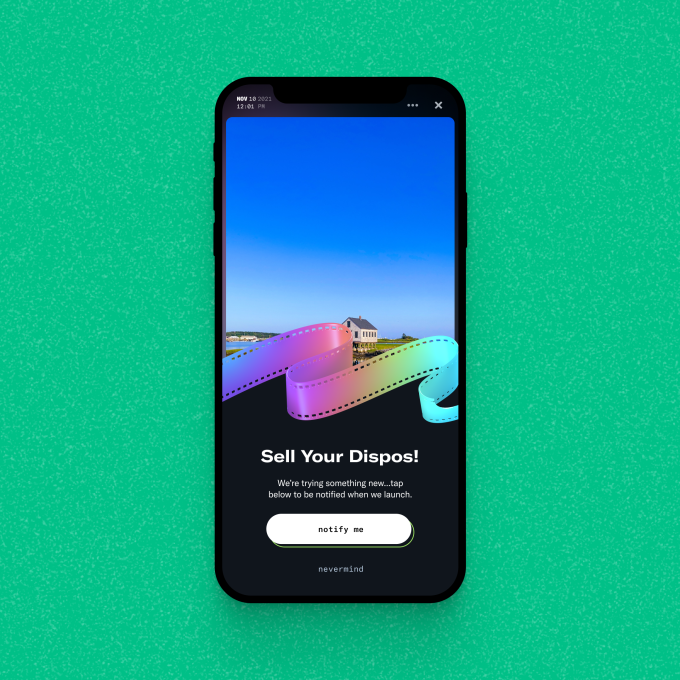
Dispo, the photo-sharing app that emulates disposable cameras, started rolling out a test yesterday that will record user interest in selling photos as NFTs. Some users will now see a sell button on their photos, and when they tap it, they can sign up to be notified when the ability to sell Dispo photos launches.
CEO and co-founder Daniel Liss told TechCrunch that Dispo is still deciding how it will incorporate NFT sales into the app, which is why the platform is piloting a test with its users. Dispo doesn’t know yet what blockchain it would use, if it would partner with an NFT marketplace or what cut of sales Dispo would take.
“I think it’s safe to say from the test that there will be an experience native to the Dispo app,” Liss said. “There are a number of ways it could look — there could be a native experience within Dispo that then connects through an API to another platform, and in turn, they’re our partner, but to the community, it would look native to the Dispo app.”
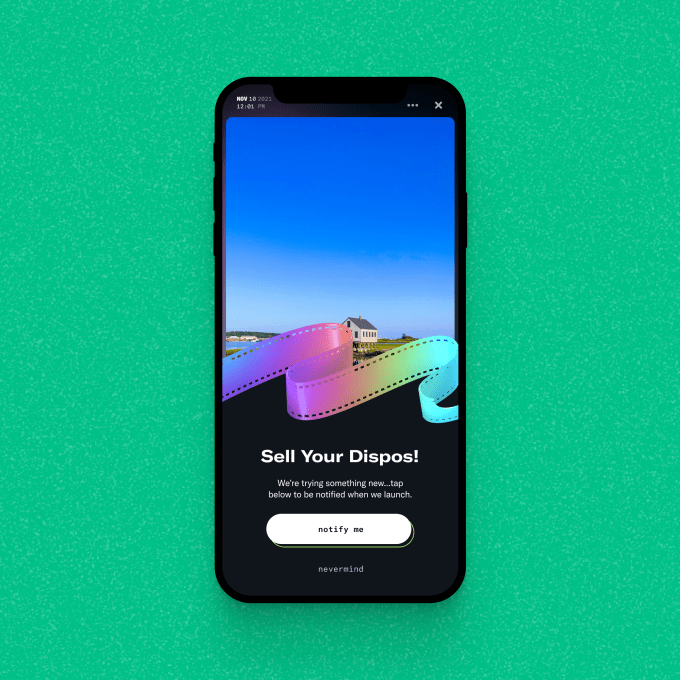
Image Credits: Dispo
This marks a new direction for the social media app, which seeks to redefine the photo-sharing experience by only letting users see the photos they took at 9 AM the next morning. From Dispo’s perspective, this gimmick helps users share more authentically, since you take one photo and then you’re done — the app isn’t conducive to taking dozens of selfies and posting the “best” image of yourself. But though it only launched in December 2019, Dispo has already faced both buzzy hype and devastating controversy.
Until about a year ago, the app was called David’s Disposables, named after co-founder and YouTuber David Dobrik. The app was downloaded over a million times in the first week after its release and hit No. 1 on the App Store charts. In March 2021, the app dropped its waitlist and relaunched with social network features, but just weeks later, Insider reported sexual assault allegations against a member of Vlog Squad, Dobrik’s YouTube prank ensemble. In response, Spark Capital severed ties with the company, leading to Dobrik’s departure. Other investors like Seven Seven Six and Unshackled Ventures, which contributed to the company’s $20 million Series A round, announced that they would donate any profits from their investments in Dispo to organizations working with survivors of sexual assault.
Liss told TechCrunch in June, when the company confirmed its Series A, that Dobrik’s role with the company was as a marketing partner — Liss has been CEO since the beginning. In light of the controversy, Liss said the app focused on improving the product itself and took a step back from promotion.
According to data from the app analytics firm SensorTower, Dispo has reached an estimated 4.7 million global installs to date since launch. Though the app saw the most downloads in January 2020, when it was installed over 1 million times, the app’s next best month came in March 2021, when it removed its waitlist — that month, about 616,000 people downloaded Dispo. Between March and the end of August, the app was downloaded around 1.4 million times, which is up 118% year over year compared to the same time frame in 2020 — but it should be expected that this year’s numbers would be higher, since last year, the app’s membership was exclusive.

Image Credits: Dispo
Now, with the announcement that Dispo is pursuing NFTs, Liss hopes that his company won’t just change how people post photos, but what the relationship will be between platforms and the content that users create.
“Why NFTs? The most powerful memories of our lives have value. And they have economic value, because we created them, and the past of social media fails to recognize that,” Liss told TechCrunch. “As a result, the only way that a creator with a big following is compensated is by selling directly to a brand, as opposed to profiting from the content itself.”
Adding NFT sales to the app offers Dispo a way to profit from a cut of user sales, but it stands to question how adding NFT sales could impact the community-focused feel of Dispo.
“I think there is tremendous curiosity and interest,” Liss said. “But these problems and questions are why we need more data.”
-

 SEO6 days ago
SEO6 days agoGoogle Limits News Links In California Over Proposed ‘Link Tax’ Law
-

 SEARCHENGINES6 days ago
SEARCHENGINES6 days agoGoogle Core Update Volatility, Helpful Content Update Gone, Dangerous Google Search Results & Google Ads Confusion
-
SEARCHENGINES7 days ago
Daily Search Forum Recap: April 12, 2024
-

 SEO6 days ago
SEO6 days ago10 Paid Search & PPC Planning Best Practices
-

 MARKETING6 days ago
MARKETING6 days ago2 Ways to Take Back the Power in Your Business: Part 2
-

 PPC6 days ago
PPC6 days agoCritical Display Error in Brand Safety Metrics On Twitter/X Corrected
-

 SEARCHENGINES5 days ago
SEARCHENGINES5 days agoWeekend Google Core Ranking Volatility
-

 MARKETING4 days ago
MARKETING4 days ago5 Psychological Tactics to Write Better Emails














